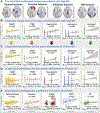Reward Processing in Novelty Seekers: A Transdiagnostic Psychiatric Imaging Biomarker
- PMID: 33875230
- PMCID: PMC8322149
- DOI: 10.1016/j.biopsych.2021.01.011
Reward Processing in Novelty Seekers: A Transdiagnostic Psychiatric Imaging Biomarker
Abstract
Background: Dysfunctional reward processing is implicated in multiple mental disorders. Novelty seeking (NS) assesses preference for seeking novel experiences, which is linked to sensitivity to reward environmental cues.
Methods: A subset of 14-year-old adolescents (IMAGEN) with the top 20% ranked high-NS scores was used to identify high-NS-associated multimodal components by supervised fusion. These features were then used to longitudinally predict five different risk scales for the same and unseen subjects (an independent dataset of subjects at 19 years of age that was not used in predictive modeling training at 14 years of age) (within IMAGEN, n ≈1100) and even for the corresponding symptom scores of five types of patient cohorts (non-IMAGEN), including drinking (n = 313), smoking (n = 104), attention-deficit/hyperactivity disorder (n = 320), major depressive disorder (n = 81), and schizophrenia (n = 147), as well as to classify different patient groups with diagnostic labels.
Results: Multimodal biomarkers, including the prefrontal cortex, striatum, amygdala, and hippocampus, associated with high NS in 14-year-old adolescents were identified. The prediction models built on these features are able to longitudinally predict five different risk scales, including alcohol drinking, smoking, hyperactivity, depression, and psychosis for the same and unseen 19-year-old adolescents and even predict the corresponding symptom scores of five types of patient cohorts. Furthermore, the identified reward-related multimodal features can classify among attention-deficit/hyperactivity disorder, major depressive disorder, and schizophrenia with an accuracy of 87.2%.
Conclusions: Adolescents with higher NS scores can be used to reveal brain alterations in the reward-related system, implicating potential higher risk for subsequent development of multiple disorders. The identified high-NS-associated multimodal reward-related signatures may serve as a transdiagnostic neuroimaging biomarker to predict disease risks or severity.
Keywords: ADHD; Attention-deficit/hyperactivity disorder; MDD; Major depressive disorders; Novelty seeking; Reward processing; Schizophrenia; Substance use.
Copyright © 2021 Society of Biological Psychiatry. Published by Elsevier Inc. All rights reserved.
Conflict of interest statement
The authors report no biomedical financial interests or potential conflicts of interest.
See the Supplement for the full list of IMAGEN Consortium collaborators.
The supervised fusion code has been released and integrated in the Fusion ICA Toolbox (FIT,
IMAGEN Consortium Authors: Gunter Schumann, M.D.; Tobias Banaschewski, M.D., Ph.D.; Gareth J. Barker, Ph.D.; Arun L.W. Bokde, Ph.D.; Erin Burke Quinlan, Ph.D.; Sylvane Desrivières, Ph.D.; Herta Flor, Ph.D.; Antoine Grigis, Ph.D.; Hugh Garavan, Ph.D.; Penny Gowland, Ph.D.; Andreas Heinz, M.D., Ph.D.; Jean-Luc Martinot, M.D.; Marie-Laure Paillère Martinot, M.D.; Eric Artiges, M.D.; Frauke Nees, Ph.D.; Dimitri Papadopoulos Orfanos, Ph.D.; Tomáš Paus, M.D., Ph.D.; Luise Poustka, M.D.; Sarah Hohmann, M.D.; Juliane H. Fröhner, M.S.; Michael N. Smolka, M.D.; Henrik Walter, M.D., Ph.D.; Robert Whelan, Ph.D.
Supplementary material cited in this article is available online at
Figures





References
-
- Peters J, Bromberg U, Schneider S, Brassen S, Menz M, Banaschewski T, et al. (2011): Lower ventral striatal activation during reward anticipation in adolescent smokers. Am J Psychiatry 168:540–549. - PubMed
Publication types
MeSH terms
Substances
Grants and funding
- MR/S020306/1/MRC_/Medical Research Council/United Kingdom
- P20 GM103472/GM/NIGMS NIH HHS/United States
- P30 GM122734/GM/NIGMS NIH HHS/United States
- R01 EB005846/EB/NIBIB NIH HHS/United States
- R01 MH085772/MH/NIMH NIH HHS/United States
- MR/N000390/1/MRC_/Medical Research Council/United Kingdom
- MR/R00465X/1/MRC_/Medical Research Council/United Kingdom
- U54 EB020403/EB/NIBIB NIH HHS/United States
- R01 MH117107/MH/NIMH NIH HHS/United States
- MRF-058-0004-RG-DESRI/MRF_/MRF_/United Kingdom
- MRF-058-0009-RG-DESR-C0759/MRF_/MRF_/United Kingdom
- R56 AG058854/AG/NIA NIH HHS/United States
LinkOut - more resources
Full Text Sources
Other Literature Sources
Medical
Miscellaneous

